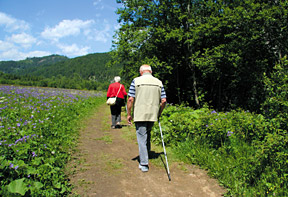|
It’s a simple formula: People who are physically active are healthier, less likely to develop chronic diseases, and have better aerobic fitness compared to people who don’t. In short, physical activity gives you a great chance to enjoy a long, healthy life – and who could ask for more than that? And yet despite the clear health benefits of regular physical activity, the Centers for Disease Control and Prevention (CDC) reports that over half of American adults do not engage in physical activity at levels consistent with public health recommendations. Are you guilty as charged? According to the CDC, adults need to engage in at least 2½ hours (150 minutes) each week of moderate-intensity aerobic activity to achieve substantial health benefits. Examples include brisk walking (3 miles per hour), bicycle riding (less than 10 miles per hour), ballroom dancing, or general gardening. Indeed, aerobic activities that keep you moving are integral to an anti-aging lifestyle. Let’s review some of the wide-ranging benefits of physical activity; then get up and get moving with some physical activity of your own! 1. Help Your Heart While a routine program of physical exercise has been shown to reduce the risk of premature death in people with coronary artery disease, Richard V. Milani, from the Ochsner Clinic Foundation, and colleagues investigated how psychosocial stress influences the effects of exercise training. The team followed 522 cardiac patients, including 53 who had high stress levels and 27 control patients who had high stress levels but did not engage in cardiac rehabilitation. The study subjects were offered 12 weeks of exercise classes consisting of 10 minutes of warm-up, 30 to 40 minutes of aerobic exercise (walking, rowing, jogging, or similar), and then a 10-minute cooldown stretch.
Source: Richard V. Milani, Carl J. Lavie. “Reducing Psychosocial Stress: A Novel Mechanism of Improving Survival From Exercise Training.” American Journal of Medicine, October 2009. 2. Grow Brain Cells In that a number of previous studies have suggested regular exercise improves brain health, David J. Creer, from the National Institute on Aging, and colleagues studied the underlying mechanisms dictating how exercise improves information processing. The researchers prompted adult mice to uses running wheels, finding that doing so increased their number of brain cells and enabled them to perform better at spatial learning tests compared to mice that did not exercise. The exercising mice were better able to tell the difference between the locations of two adjacent identical stimuli, an ability that the team found to be closely linked to an increase in new brain cell growth in the hippocampus portion of the brain. Source: Creer DJ, et al. “Running Enhances Spatial Pattern Separation in Mice.” Proceedings of the National Academy of Sciences, Jan. 19, 2010. 3. Fight Breast Cancer Canadian researchers explored how sex hormones are positively influenced by aerobic exercise, examining how an aerobic exercise intervention influenced circulating estradiol, estrone, sex hormone-binding globulin (SHBG), androstenedione, and testosterone levels, which may impact breast cancer risk. The researchers enrolled 320 postmenopausal women, ages 50 to 74 years, in a year-long trial, with 160 women randomly assigned to 225 minutes a week of aerobic exercise, and the remaining study subjects maintaining their normal level of activity. At the end of the study, the team found statistically significant reductions in estradiol and free estradiol, as well as increases in SHBG, among the exercising women compared to controls. While these hormonal changes were modest, the researchers stated: “This trial found that previously sedentary postmenopausal women can adhere to a moderate- to vigorous-intensity exercise program that results in changes in estradiol and SHBG concentrations that are consistent with a lower risk for postmenopausal breast cancer.” Source: Friedenreich CM, et al. “Alberta Physical Activity and Breast Cancer Prevention Trial: Sex Hormone Changes in a Year-Long Exercise Intervention Among Postmenopausal Women.” Journal of Clinical Oncology, Feb. 16, 2010. 4. Build Strong Bones Wolfgang Kemmler, from Freidrich-Alexander University (Germany), and colleagues analyzed data on 246 older women who were enrolled in the Senior Fitness and Prevention (SEFIP) Study. The researchers found that women who exercised had higher bone density in their spine and hip, and also had a 66 percent reduced rate of falls. Fractures due to falls were twice as common in the controls versus the exercise group (12 vs. six incidents). The authors’ conclusion: “Compared with a general wellness program, our 18-month exercise program significantly improved [bone mineral density] and fall risk.” Source: Wolfgang Kemmler W, et al. “Exercise Effects on Bone Mineral Density, Falls, Coronary Risk Factors, and Health Care Costs in Older Women: The Randomized Controlled Senior Fitness and Prevention (SEFIP) Study.” Archives of Internal Medicine, January 2010. Anxiety often remains unrecognized or untreated among patients with a chronic illness, and may have deleterious consequences including declines in quality of life and lack of compliance with the treatment plan. Matthew P. Herring, from the University of Georgia, and colleagues analyzed the results of 40 randomized clinical trials involving nearly 3,000 patients with a variety of chronic medical conditions, including heart disease, multiple sclerosis, cancer and chronic pain from arthritis. The researchers found that, on average, patients who exercised regularly reported a 20 percent reduction in anxiety symptoms compared to those who did not exercise. “Exercise training programs lasting no more than 12 weeks, using session durations of at least 30 minutes, and an anxiety report time frame greater than the past week resulted in the largest anxiety improvements,” said the researchers. Source: Herring MP, et al. “The Effect of Exercise Training on Anxiety Symptoms Among Patients: A Systematic Review.” Archives of Internal Medicine, 2010. 6. Defend Against Stroke Jacob R. Sattelmair, from Harvard School of Public Health, and colleagues examined the effects of a variety of leisure-time activities on stroke risk in women. Relying on data on 39,315 healthy American women, ages 45 years and over, enrolled in the Women’s Health Study, the team investigated the subjects’ physical activity at the study’s start and at five points during a follow-up period of nearly 12 years, and tracked the incidence of stroke during the same time frame. The researchers found that those women who engaged in moderately intense exercise during the study period were at a markedly lower risk of stroke; specifically, walking time and pace were inversely related to the risk of any stroke, ischemic stroke, and hemorrhagic stroke (longer time, faster pace = lower stroke risk). Stroke risk declined by as much as 37 percent as the pace of walking increased from less than 2 to more than 3 miles/hour. Source: Jacob R, et al. “Physical Activity and Risk of Stroke in Women.” Stroke, April 2010. 7. Enjoy Your Golden Years In that physical activity is associated with reduced risks of chronic diseases and premature death, Qi Sun, from Harvard School of Public Health, and colleagues explored whether physical activity is also associated with improved overall health among those who survive to older ages. Analyzing data from 13,535 participants in the Nurses’ Health Study, (women reported their physical activity levels in 1986 when 60 years of age, on average), the team found that those women who survived to age 70 or older as of 1995-2001 engaged in higher levels of physical activity at the beginning of the study and were less likely to have chronic diseases, heart surgery or any physical, cognitive or mental impairments. According to the researchers, “These data provide evidence that higher levels of midlife physical activity are associated with exceptional health status among women who survive to older ages and corroborate the potential role of physical activity in improving overall health.” Source: Qi Sun, et al. “Physical Activity at Midlife in Relation to Successful Survival in Women at Age 70 Years or Older.” Archives of Internal Medicine, 2010. 8. Make the Move Toward Better Health
7 for Starters: Exercise for Good Health So, let’s review. Research suggests consistent physical activity can accomplish the following:
And that’s just for starters! Read previous (and upcoming) issues of To Your Health to learn about the countless benefits of exercise and the best ways to do it. Talk to your doctor for more information. By Drs. Ronald Klatz and Robert Goldman Ronald Klatz, MD, is the president of the American Academy of Anti-Aging (www.worldhealth.net), a nonprofit organization dedicated to the prevention, detection and treatment of aging-related disease. Robert Goldman, MD, is the chairman of the American Academy of Anti-Aging (www.worldhealth.net), a nonprofit organization dedicated to the prevention, detection and treatment of aging-related disease. |


